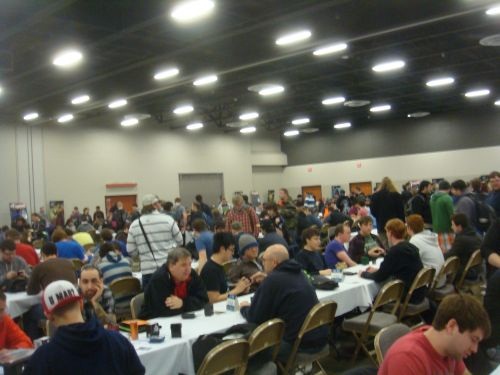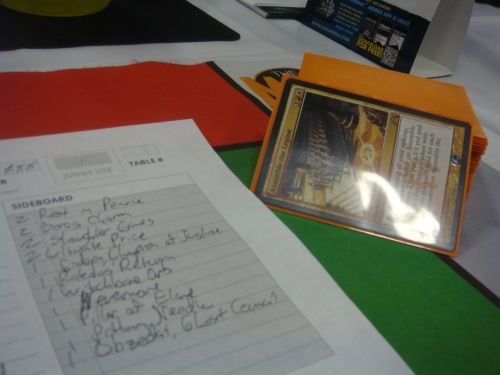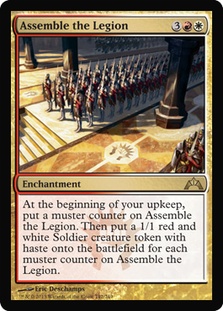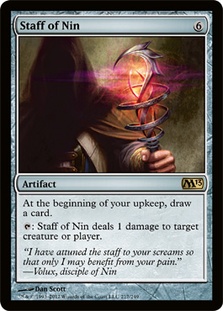Hey there, readers! Today I’ve got a fun deck for you, and it’s a bit different from the others—it’s actually mildly competitive! If you read last week’s article, you’ll know that this past weekend I trudged up to Cincinnati for some Standard action at the SCG Open Series. The deck I brought along was one that had been simmering for several weeks. Let’s take a look at the inspiration for the list.
As I was browsing the Gatecrash spoiler for some goodies a few weeks ago, I saw the Legion and passed it over pretty quickly. Expensive, do-nothing enchantment that makes tiny guys, right? Yes, that was my response at first blush, too. However, I took another glance when I cracked one in a pack. After a bit of study, I thought the card seemed like Goblin Assault from several years ago and a bit like Bitterblossom about a year before that. However, I underestimated the value of one particular clause.

Unlike the others, which produce one at a time, this card continually adds more and more creatures until you can either block forever or throw monstrous amounts of red and white Soldiers at your opponent’s face. The thing I like most about Assemble the Legion is that you never lose board development; they could Wrath your board, sure, but you’ll get just about as many Soldiers back the next turn! Most conventional sweeper effects do not permanently deal with the Legion’s Soldiers, and only a small number of decks can target the enchantment itself pre-board or post-board. It doesn’t need any help or maintenance. It is a one-card combo, so let’s find some support and get cracking!
Here is the original list the ol’ noggin came up with about two weeks ago.
Creatures (12)
Lands (24)
Spells (24)

As you can see, I originally opted for a bit of Soldier tribal action and was more interested in just digging for the Legion and dealing with early threats. I had some creatures to preserve, and with Divine Reckoning being the closest thing to a four-cost mono-white Wrath, I threw a couple of those into the mix. In goldfishing, the deck played really well, but it was not very resilient and almost completely relied on resolving the Legion to make things work. It was also a bit flat and uninteresting, and I knew it could be better.
This deck, more than most of my other brews, has evolved significantly since its conception. Before long, I decided I needed to branch into another color. Blue was fine, as it had Supreme Verdict, countermagic, and a bit of draw power to get to the combo piece, and green seemed ok, with ramp, solid creatures, and NCP removal to keep the Legion around. Black, on the other hand, had an interesting array of choices. Bleeding the deck into Orzhov offered me several synergetic card choices as well as some added depth in the sideboard. Removal became sturdier, too, which seemed relevant against the aggro decks that were dominating the Standard metagame.
As the Cincinnati Open drew closer, I decided I wanted to build a W/B/R (I like to call the wedge "Webber") deck that utilized the core power of Assemble the Legion, powerful and on-time spot removal, and unorthodox card advantage engines to make the final list. I was still shaky on some card choices, but I was out of time.
Enter SCG Standard Open: Cincinnati.

After crashing with a college pal on the Kentucky side of the Ohio River and spending an evening watching our fair share of Duck Dynasty, I awoke rested and ready to try my newest deck out. Cincinnati is particularly special to me; a year ago, I wrote my first article for SCG about my 4th place finish in a Draft Open there. Now I was here to try Standard at the largest Constructed tournament I’d ever seen. With a homebrew. No pressure.

I arrived a hair before 8:00 AM and sat down to look over my list one more time. It seemed so bad under the cold, hard fluorescent lighting of the game hall. I heard other players announcing their Huntmaster of the Fells and Geist of Saint Traft while they playtested with friends; for a split second, I considered calling an audible. Maybe this deck is too cute, and I already have the stuff to build Jund Aggro with me, I thought. I knuckled down to register my deck and pored over my card choices. A couple neighboring folks took a look and liked what they saw and, after adding a couple last-minute card choices (and trading for one), I swallowed my fear and registered this pile.

Creatures (8)
Planeswalkers (2)
Lands (25)
Spells (25)

Before I get into how the event went, let’s look at the deck.
Creatures: High Priest of Penance and Boros Reckoner
In my move to the Webber wedge and recognizing the importance of combat and damage-based removal in Standard, High Priest of Penance seemed like an ideal two-drop against the aggressive game plan. With very little commitment, you can stop a weak hand that’s light on creatures or prevent attacks entirely when your opponent has any other important nonland permanent to preserve, like a planeswalker or crucial enchantment. This deck deals damage, too, so being able to deal with an NLP can be relevant, cheap, and easy. In the realm of red-based aggro decks, the High Priest felt like a winner.
The Reckoner, who was in this list long before his double-digit price tag, acts as an important wall against aggressive 2/2 decks as well as a combo piece with the three maindecked Blasphemous Acts. This card does a great deal of work, and every colored land can cast him, so he seemed like a no-brainer.
Spells
Assemble the Legion
Muster the troops!
Burning Oil
The only noncreature playset, Burning Oil is a value engine against a wide variety of aggressive decks. It can deal with Thragtusk and his pal, a Strangleroot Geist, Boros Reckoner, Hellrider, and Frontline Medic in response to his trigger, all on the cheap. The attacking or blocking clause is often irrelevant; aggressive decks live in the red zone anyway. They’ve already bought the timeshare. In a pinch, I can even use it to hit my High Priest when attacking or to kill my Boros Reckoner at the end of the combat step (or after first strike activation) to damage the player or another creature. Burning Oil is a great tool in the format since it’s a two-sided Searing Spear that helps you get ahead in card advantage against aggressive draws.
Blasphemous Act
I’ve been a longtime proponent of this card alongside Stuffy Doll, and now with the prevalence of Boros Reckoner, it has a legitimate home in top-table decks. My Legion can often provide enough dudes to make this a one-mana Wrath, and with two Reckoners on my side? Forget about it! It triggers my High Priest too, and it’s, well, just a Wrath other times.
Trading Post
I have to thank Shaheen Soorani for this inclusion. After hearing him talk about how Trading Post is such a good "planeswalker" against aggro decks, I was sold. I love this card with a passion, and I couldn’t wait to sleeve it up. I had enough artifacts that most of its modes were relevant at any point in the game. It can make a Goat to add to the Blasphemous tally or as a great chump blocker for Boros Reckoner, it can pitch lands and flashback spells for life, or it can be a five-mana cycle. I could even sack a mustered Soldier to get a Keyrune back, though that’s fairly uncommon.
Lingering Souls
I wavered on the inclusion of the Souls. It came in and out a couple times in playtesting. This card still adds four evasive Spirits, though, and they’re very helpful against non-Rancor decks and as a recovery option after a board sweep.
Blind Obedience
This card impressed me the more I playtested with it. It gives your deck reach as well as protection from the Thundermaw Hellkites, Hellriders, and Strangleroot Geists that own the format. I don’t mind drawing a second copy, either; I’ll take double extort triggers any day in a flashback deck!
Auger Spree
This card was a bit of a long shot, but hear me out! Auger Spree is one of the only unconditional removal spells for about 99% of targetable creatures that are on par with its mana cost. Sure, it can’t kill Obzedat, Thundermaw Hellkite, or Bazaar Krovod (seeing play at a tournament near you!), but those folks are hard to answer anyway. This does kill a wide variety of creatures, all at instant speed. It kills Boros Reckoners cleanly, Restoration Angel, Aurelia the Warleader, Loxodon Smiter, Predator Ooze, Olivia Voldaren (when she’s not too pumped), a flipped Huntmaster of the Fells, and other aggressive and midrange targets.
It’s a nice response to Boros Charm, which has become the aggro deck’s response to conventional damage-based or "destroy" removal. It can only be used offensively on two targets, my own Obzedat or an animated Gideon, but it’s still a high-quality, underplayed removal spell that I think the metagame needs.
Pillar of Flame
In a world of Rakdos Cacklers and Experiment Ones, this remains a relevant removal spell. We’ve come a long way from Shock, but this is what we have, so this is what we use. After a particularly spicy rumble with Reckoner + Act, you can also aim for their pearly whites.
Sorin, Lord of Innistrad
Let me begin by saying that Sorin is fairly weak in an aggressive environment from my experience. The 1/1 he makes is pretty flimsy when compared to a 4/2 trampler or a 3/4 flyer. His -1, on the other hand, is where he’s best. The emblem doubles the power of your Legion tokens, High Priest (making him more likely to be a two-for-one), and gives your Lingering Souls a little boost, too. Most of the time, he will be a non-interactive Anthem effect for my team. If I’m holding the Legion, turn 4 Sorin, emblem, turn 5 Legion, Vampire token, turn 6 pop Sorin and start beating down with my 3/1s. That’s why he’s really here.
Keyrunes
Rakdos Keyrune is still, in my opinion, the best Keyrune in combat. First strike is huge on this bloke, and it creates either a short clock or an intimidating blocker. Speaking of blockers, Orzhov Keyrune is a great wall. It stonewalls every 3/3 (except, of course, Boros Reckoner). It is just as relevant on the offense as Vampire Nighthawk without the weakness to Searing Spear or Ultimate Price. The Keyrunes were put in to accelerate the Legion out on turn 4 and get the ball rolling. The deck is full of three-drops, so choosing the right one to cast is very game specific. In a slow match, an on-time Keyrune is an excellent play for an otherwise ramp-less color combination.
Sever the Bloodline
This removal spell is as powerful as targeted removal gets in Standard, and the ability to flash it back is just gravy. True, it’s slow and often just spot removal, but it exiles all the Beasts, Spirits and mana dorks, too.
Staff of Nin
The Staff of Win is the top end of this deck, and it does everything you need. It provides inevitability both through draw and damage, and it synergizes very well with High Priest of Penance. You don’t lose a card pinging your Cleric, and you can do it on demand with no mana investment. There are a lot of decks that can’t beat this card thanks to either or both of its abilities, but its steep mana cost can often make it dangerous to include more than one copy.
Lands
The land base is fairly clear, but I want to distinguish one thing. First, I played three Blood Crypts intentionally; in an aggro-heavy format, I didn’t want half my lands to come into play and Shock me. The Dragonskull Summit eases the life strain while providing the same mana fixing that Blood Crypt offers. Two Vault of the Archangels is pretty greedy in a color-hungry deck. However, using it with a High Priest to block guarantees a two-for-one, and it helps push your mustered Soldiers through to win a close race.
Sideboard
This sideboard is a bit transformative. Muster Buster plays like a slow midrange deck with cheap removal pre-board, and I can side in fairly specific answers to become a full-fledged control deck. The two copies of Rest in Peace have been in the sideboard since day one, and a lot of decks can’t win with this permanent in play unless they find their Abrupt Decay or Ray of Revelation. Rest in Peace replaces Lingering Souls in game 2.
Boros Charm has an unusual application here. Instead of preserving an army from a board wipe, Boros Charm is meant to capitalize on the damage being dealt to these creatures. In an aggressive match, the High Priests might need to be used twice; this allows me to block, Charm, kill something, then rinse and repeat. Similarly, casting Blasphemous Act and Charming saves the team, the opponent takes thirteen, and any Reckoners and mustered Soldiers are still around to deal the final blow!
In addition, the Flame Rift mode can be effective, but often not to kill players. If you’ll notice, most of the format’s planeswalkers come in with three counters and add a loyalty counter for their first ability. Garruk, Primal Hunter, Sorin, Lord of Innistrad, Domri Rade, Liliana of the Veil, and Jace, Memory Adept can all be killed even after using their most common ability. Though this is an auxiliary use, some decks run a lot of ‘walkers, so it’s nice to have an answer ready.
Slaughter Games, along with Nevermore, is used in different situations. Although I’m pretty sure Slaughter Games is just an all-around better card (can’t be countered, exiles cards instead of just preventing play, and exposes their hand), Nevermore has one important distinction: it’s only three mana. Although normally I’d just play three Slaughter Games, I mixed it up for fear that they would Slaughter Games my Slaughter Games. Also, with it being cheaper, I can resolve it turn 3 on the play and stop whatever nonsense they have planned. Boros Reckoner, Restoration Angel, even Farseek if they’ve missed a land drop can be backbreaking. Calling Abrupt Decay or Detention Sphere is also handy because it protects Nevermore itself against common answers.
Ultimate Price is fine for additional removal, but having limited targets relegates it to the sideboard. Gideon, Champion of Justice is a good card against midrange, and any deck that can’t exile him will have a problem. In my experience, his best mode is to +1 the turn he comes in and then beat down every turn after that even if the creature volume increases. Rakdos’s Return is also good against midrange. Let them Farseek and Keyrune all day, blow them out with this champ, and watch ’em topdeck. Witchbane Orb is nice for all the "target opponent" stuff your opponent has planned. Normally it would come in during the slower, noncombat matchups such as mill, life drain, or enormous X spell decks. It also shrugs off a Curse of Death’s Hold, which blanks the deck.
I have an extra Pillar of Flame for aggro matchups. Pithing Needle was added at first to deal with Izzet Staticaster, but it mainly deals with planeswalkers, Deathrite Shaman, and a whole lot more. You don’t realize how important an activated ability is to a permanent until it is Needled. Finally, Obzedat was included for the midrange/can’t-beat-a-5/5-that’s-immune-to-sorceries decks. He was a last minute replacement, so I did not get a chance to test with him, though nearly everything else had seen play before Saturday.
Speaking of Saturday, let’s talk about the Open! This was my first large Standard tournament. Most of the large tournament Magic I’ve played was Limited, so this was a fresh take on the competitive aspect of the game. According to the judges’ counts, 679 players participated, making it the third-largest Standard Open ever. I was really excited to be a part of it, and before long we were off!
Now, instead of doing a round-by-round, let me just give you a breakdown with some notes.
Round 1: Matt (Naya Humans) 2-0
Round 2: Christian (Mono Red w/ Rancor) 0-2
Round 3: Brian (Jund Midrange) 2-1
Round 4: David (Esper Spirits) 0-2
Round 5: Tanner (Jund Midrange) 0-2
Round 6: Coty (BUG Tempo) 2-0
Round 7: Clayton (Jund Midrange) 2-0
Round 8: Kyosuke (G/W Ooze) 1-2 Drop
Record: 4-4
For those of you that were watching SCGLive, you might have noticed I was featured round 2 with Christian Valenti. For those who didn’t, here is the gist of the big play that match. Game 1 was a close one. I had to make some awkward moves, and I was forced to play around Searing Spear and Skullcrack for much of the game. I was at three, and he was at five. He attacked with a Rancored Ash Zealot and a Rancored Boros Reckoner, and I had a High Priest out with a Burning Oil in the bin and enough mana to flash it back. I knew there was a reason I hadn’t used Burning Oil, but the Zealot’s trigger slipped my mind, so I did that instead of this significantly better life-saving play.
If I had blocked either attacker with the High Priest, pinged the Priest to kill his Reckoner, and tapped the Post to gain life, I would have gone back to three and might have been able to scrape by with a win. There were so many potentially lethal cards he could cast that I had to slowroll the Trading Post activation in case he Bolted in response. In my mind, Burning Oil on the Zealot plus High Priest shenanigans would have effectively led to the same result except I’d be a card up. But I forgot the Zealot trigger. The fact that he clobbered me so hard in game 2 was actually welcomed. Still, I would have accepted a 1-1 draw.

This is what overlooking Ash Zealot’s trigger looks like.
Throughout the day, I played against more Jund Midrange decks than anything, but my stack pairs up fairly well against it. Assemble the Legion is often untouchable, and barring Abrupt Decay, it is difficult to favorably interact with the Cleric and Wizard.
Everyone I played was polite, a good sport, and in general quite knowledgeable about the game’s intricacies, creating a fulfilling and rewarding tournament experience. Christian, a fellow I had played (and lost to) in a Zendikar Sealed PTQ about four years ago, was extremely courteous and humble.

Regarding the deck, I was really pleased with how well it played. Given the current card pool and design constraints, the theme of this deck was surprisingly well maintained. Most of my losses can be blamed on bad keeps on my part, an awkward draw, or the occasional nationally broadcasted punt. Boros Reckoner was as awesome as advertised, and the High Priest pulled his weight. Out of all the cards in my deck, though, Staff of Nin was probably the all-star.
Untapping with this card put me firmly in the driver’s seat. This deck is an honest-to-goodness control deck, not really a midrange deck as I originally expected. As such, the Staff helped me grind out advantage each turn. It was complementary to the High Priests, and in combat, it gave my shrimpy squad a bit more punch.
Auger Spree was excellent every time I drew it. For three mana, you can answer so many creatures—and at instant speed, too. I’d honestly play another over Sever the Bloodline in a heartbeat; this deck and this format love this card. Boy, do I miss Dismember, though.
Maindeck, my biggest underperformer was probably Lingering Souls. Yes, it’s a great card, but with basically only Sorin supporting it, it’s just an easier-to-cast and evasive Goblin Rally. This deck doesn’t really need that type of effect.
The sideboard turned out to be pretty potent against a wide array of opponents. Rakdos’s Return made it in during most matches and was vicious each time I drew it. In round 3, I played an on-time X=4 Return that drained his hand and killed his freshly cast Garruk, Primal Hunter. The extra Pillar was a blessing, and I cast all three in one game in round 8. Boros Charm saw the least play; in situations where my opponents were hitting me as hard as they were, I found I wanted more removal like Ultimate Price and the extra Pillar of Flame.
Also, I think every time I resolved either version of Cranial Extraction, I named an irrelevant (or even absent) card; in round 4, I named Geist of Saint Traft with my turn 3 Nevermore instead of Detention Sphere (which is what I would normally name against Esper or Bant). My opponent followed up that misplay by casting two Detention Spheres, one each for all my Spirit tokens and again for my Staff of Nin. I have trouble with Extraction-type cards, so I probably need more practice with them to be more certain of each choice.
In short, I consider the tournament a success despite a 4-4 finish. For my first large-scale Standard tournament, it could have gone much worse. I received a lot of comments about the deck and was pleased that the homebrew got there at least a little bit. I’m sure there are lots of cards that can be included and others that can be tossed aside. Let me know what you think about this or your own first competitive Standard experience!
Thanks for reading, and I’ll be back next week with another fun brew. Until then, don’t forget to untap!
– Matt
CaptainShapiro on Magic Online


